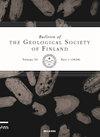Some new insights into the geochronology of the Western Karelia Subprovince, Finnish Lapland
IF 1.3
4区 地球科学
Q2 GEOLOGY
引用次数: 0
Abstract
Archean terranes are generally poorly exposed and structurally complicated, making models of geological evolution difficult to establish. Because of pervasive metamorphism, strong deformation, and poorly exposed bedrock, the stratigraphy, geochronology, and geological evolution of the northeastern part of the Archean Western Karelia Subprovince, Finnish Lapland, is still deficient. Three new U-Pb age determinations were made using the LA-ICP-MS method on zircon in search of more profound understanding of the geochronology of the area. Data from the Pultoselkä granite yield an age of 2795±5 Ma, providing a minimum age of 2.8 Ga for the Tulppio suite. The age is coeval with widespread 2.74–2.70 Ga granitoids of the Karelia Province, likely representing the same magmatic event. The data from the Kontioselkä pegmatite define a maximum age for the pegmatite and a minimum age for mafic volcanic rocks in Kontioselkä at 1781±27 Ma. The age coincides with major deformation and metamorphism in the Karelia Province around 1.76 Ga. Zircon from the Jänesselkä mafic-ultramafic complex yields a minimum age of 2425±17 Ma, complying rather well with the 2.5–2.4 Ga mafic layered intrusions of the northern Fennoscandian Shield. Our new data show that the Archean of the northeastern part of the Western Karelia Subprovince was affected by Proterozoic thermal events more extensively than thus far perceived.芬兰拉普兰西卡累利阿省地质年代学的一些新见解
太古代地体一般暴露程度较差,构造复杂,地质演化模式难以建立。由于太古代西部卡累利阿省东北部变质作用普遍,变形强烈,基岩暴露程度低,在地层学、年代学和地质演化方面仍存在不足。利用LA-ICP-MS对锆石进行了3次新的U-Pb年龄测定,以期对该地区的年代学有更深入的了解。Pultoselkä花岗岩的年龄为2795±5 Ma,为Tulppio套件提供了2.8 Ga的最小年龄。其年龄与卡累利阿省广泛分布的2.74 ~ 2.70 Ga花岗质同期,可能代表同一岩浆事件。Kontioselkä伟晶岩资料确定了Kontioselkä伟晶岩的最大年龄和基性火山岩的最小年龄,分别为1781±27 Ma。年龄与卡累利阿省1.76 Ga左右的大变形变质作用相吻合。Jänesselkä基性-超基性杂岩锆石的最小年龄为2425±17 Ma,与北芬诺斯坎地盾的2.5 ~ 2.4 Ga基性层状侵入体吻合较好。新资料表明,西卡累利阿省东北部太古宙受元古代热事件的影响比目前所知的更为广泛。
本文章由计算机程序翻译,如有差异,请以英文原文为准。
求助全文
约1分钟内获得全文
求助全文
来源期刊
CiteScore
1.30
自引率
0.00%
发文量
5
审稿时长
>12 weeks
期刊介绍:
Bulletin of the Geological Society of Finland (BGSF) publishes research articles and short communications in all branches of geosciences. Contributions from outside Finland are welcome, provided that they contain material relevant to Finnish geology or are of general interest.

 求助内容:
求助内容: 应助结果提醒方式:
应助结果提醒方式:


